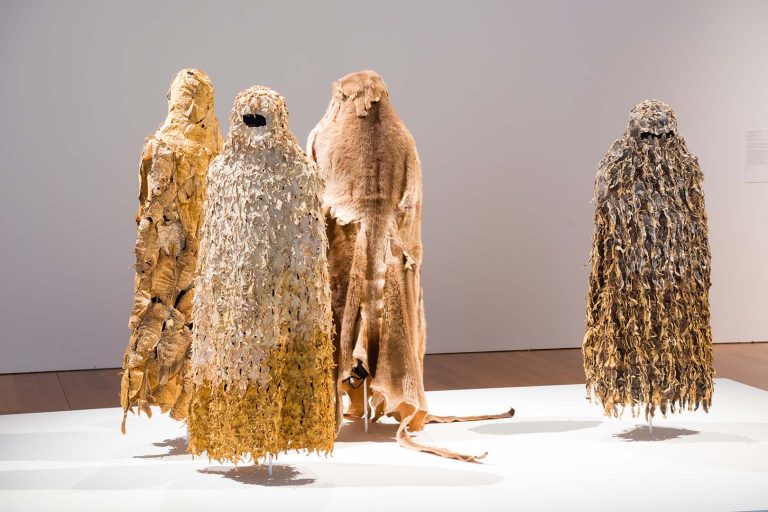We acknowledge the Traditional Owners of the land on which the Queensland Art Gallery | Gallery of Modern Art stands and recognise the creative contribution First Australians make to the art and culture of this country.

Mella Jaarsma / The Netherlands/Indonesia b.1960 / Hi inlander (installation view) 1999 / Treated skins (kangaroo, frog, fish and chicken) / 244 x 97cm (kangaroo); 140 x 84cm (frog); 150 x 100cm (fish); 152 x 95cm (chicken) / Purchased 2000. Queensland Art Gallery Foundation / Collection: Queensland Art Gallery | Gallery of Modern Art / Photograph: Natasha Harth, QAGOMA / © Mella Jaarsma
Mella JaarsmaHi inlander 1999
On Display: QAG, Gallery 5
Mella Jaarsma’s ‘second skins’ are made from Javanese ‘gurami’ fish, frog skins, chicken skin (and feet) and kangaroo hides and when worn cover the body from head to shin.
The term ‘Hi inlander’ was a Dutch colonial form of greeting to indigenous Indonesians, and was intended as a derogatory comment on their colonised status. Jaarsma’s Hi Inlander was made for ‘The 3rd Asia-Pacific Triennial of Contemporary Art’ (APT3) in 1999. During the opening night of the APT3, these skins were worn by performers who mingled with invited guests. Only the feet, hands and eyes of the performers were visible. These parts of the body permit social contact and interaction, perform collective actions, and ensure travel amongst different peoples. Despite ethnic, age and cultural difference, eyes, hands and feet are the common expressive tools of all humanity.
Hi inlander poses questions such as: what does it mean to walk around in another’s skin, to see through their eyes? More acutely, what does it feel like to live in another’s body? And does a different body make a different person?
Like many Europeans before her, Mella Jaarsma has made her life far from the land of her birth, the Netherlands. Originally trained as an artist in Groningen, then Jakarta and Yogyakarta, she has lived in Java since 1984. She is, to all intents and purposes, an Indonesian artist, since her work takes its cues and concerns from her engagement with the social and cultural life around her.
However, years of increasing political, economic and social tension in Indonesia have served to heighten her sensitivity to the linked issues of social location and different ethnicities in her adopted home. Indonesian citizens have become acutely aware of the fragility of their modern multi-racial and multi-linguistic society. Popular resentment around the economic hardships that led to the fall of the New Order focused on the assumed wealth and privilege of the ethnic Chinese minority, and civil disturbances in provinces as diverse as Ambon, East Java and Timor were fuelled by deliberate political manipulations of ancient ethnic and religious differences. In this volatile climate, the great achievements of Indonesian modernisation and cross-cultural cooperation are highly vulnerable.